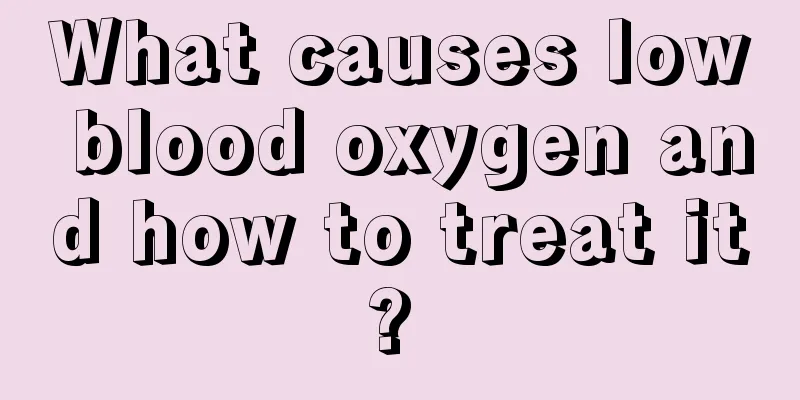What causes low blood oxygen and how to treat it?

|
Many people usually need to relieve their oxygen problems by inhaling oxygen for a short time in the hospital due to lack of oxygen or insufficient oxygen. However, even during the oxygen inhalation process, the electrocardiogram will still show symptoms of low blood oxygen. This is because the expected normal blood oxygen index is not reached. Patients with low blood oxygen have low blood pressure due to insufficient oxygen in the body, ignoring oxygen production disorders, organ dysfunction, and other factors. What to do if your blood oxygen level is low Check patient status When the blood oxygen level is low, the first thing to do is to observe the patient's complexion, breathing, and general condition. If the patient's general condition is good, there is no cyanosis of the lips, the patient's breathing is stable, and there are no abnormalities, then this may be a machine failure or a line contact failure, which can be eliminated. Auscultation of breath sounds When you find that your blood oxygen is low, you should also pay attention to auscultating the lungs' breath sounds. Auscultate the patient's lung sounds carefully to see if there is any phlegm sound. If phlegm sound is found, the patient should be instructed to cough immediately. Those who are unable to cough can be assisted to turn over and pat their backs. The phlegm accumulated on the walls of the respiratory tract can be shaken to make it fall off and cough it out. If necessary, mechanical suction can be used to suck out the phlegm in the respiratory tract, so that the patient's respiratory tract can be restored to a smooth state and oxygen exchange can be carried out. Check oxygen line passages When you find low blood oxygen, check whether the oxygen pipeline channel is unobstructed, whether the oxygen device has leaks or loose connections, whether the oxygen pipeline is twisted or under pressure, whether the oxygen nasal plug end is in the patient's nasal cavity... Only by ensuring that the oxygen pipeline output is unobstructed can oxygen be delivered to the patient and improve his hypoxia condition. Oxygen partial pressure (PO2) refers to the tension generated by oxygen molecules physically dissolved in plasma (so it is also called oxygen tension). In 100 ml of blood at 37°C, oxygen dissolved in a physical state can produce an oxygen partial pressure of 0.133 kPa (1 mmHg) for every 0.003 ml. When a normal person is at rest and breathes sea level air, the oxygen physically dissolved in the arterial blood is about 0.3 ml%, the partial pressure of oxygen in the arterial blood (PaO2) is about 13.3 kPa (100 mmHg); the normal partial pressure of oxygen in the venous blood (PvO2) is about 5.32 kPa (40 mmHg). PaO2 mainly depends on the level of alveolar oxygen partial pressure (PAO2), the amount of oxygen diffused into the blood through the alveolar membrane, and the ratio of alveolar ventilation to pulmonary blood flow. If the oxygen partial pressure of the outside air is low or alveolar ventilation is reduced, the alveolar oxygen partial pressure will decrease; or if diffusion disorder or ventilation/blood flow imbalance causes an increase in the functional or anatomical shunt of pulmonary arteriovenous blood, PaO2 may decrease. Oxygen content refers to the number of milliliters of oxygen contained in 100 milliliters of blood, including the oxygen actually bound to hemoglobin and the oxygen dissolved in plasma. Normal arterial blood oxygen content is about 19.3 ml%, and mixed venous blood oxygen content is about 12 ml%. The oxygen content in the blood mainly depends on PaO2 and the quality and quantity of hemoglobin. A significant decrease in PaO2 or a decrease in the ability of hemoglobin to bind oxygen, which reduces hemoglobin saturation, or a decrease in the amount of hemoglobin per unit volume of blood, can all reduce the oxygen content. Oxygen capacity refers to the amount of oxygen bound to hemoglobin in 100 ml of blood in vitro when the oxygen partial pressure is 19.95 kPa (150 mmHg), the carbon dioxide partial pressure is 5.32 kPa (40 mmHg), and the humidity is 38°C. Under the above conditions, normal hemoglobin can bind 1.34 to 1.36 ml of oxygen per gram. If calculated based on 15 grams of hemoglobin per 100 ml of blood, the oxygen capacity of arterial and venous blood is approximately 20 ml%. |
<<: Be careful if you often have back pain when walking because of these reasons
>>: What causes a slow heart rate?
Recommend
Can ovarian tumors be treated with drugs?
Can ovarian tumors be treated with drugs? Ovarian...
Stomach cramps and diarrhea
What is the cause of stomach pain and diarrhea? T...
Why do adults still grow teeth
Normal people will experience two tooth growth pr...
Can sweet potato leaves be eaten
Sweet potatoes are a common food in our lives, an...
Right intercostal neuralgia
Neural pain occurs between the right ribs. For th...
What to do if your hands and feet are not coordinated when dancing
Some children are born with a good sense of rhyth...
Symptoms of late stage bone metastasis of prostate cancer Dietary conditioning for patients with late stage bone metastasis of prostate cancer
In real life, some friends will suffer from prost...
What are the benefits of washing your hair with white wine
When it comes to liquor, everyone will have a cer...
Do I need to be on an empty stomach for a urine test?
Urine test is a very common test in people's ...
What's the problem with my legs suddenly going weak
Leg discomfort often occurs in the elderly, but t...
What are the treatments for anal eczema
Anal eczema is a common allergic skin disease in ...
Can push-ups train the center seam of the chest?
Push-ups are a relatively comprehensive form of e...
Will the fetus move while sleeping?
Pregnancy and childbirth is a complex and magical...
How to prevent and care for the sequelae of tonsil surgery?
Tonsils are a type of tissue in people's thro...
What causes heartburn and acid reflux? Be alert to gastric cancer!
People say that a healthy stomach means a healthy...









